Related Research Articles

A crossbow is a ranged weapon using an elastic launching device consisting of a bow-like assembly called a prod, mounted horizontally on a main frame called a tiller, which is hand-held in a similar fashion to the stock of a long gun. Crossbows shoot arrow-like projectiles called bolts or quarrels. A person who shoots crossbow is called a crossbowman or an arbalist.

A catapult is a ballistic device used to launch a projectile a great distance without the aid of gunpowder or other propellants – particularly various types of ancient and medieval siege engines. A catapult uses the sudden release of stored potential energy to propel its payload. Most convert tension or torsion energy that was more slowly and manually built up within the device before release, via springs, bows, twisted rope, elastic, or any of numerous other materials and mechanisms.

An arquebus is a form of long gun that appeared in Europe and the Ottoman Empire during the 15th century. An infantryman armed with an arquebus is called an arquebusier.

The repeating crossbow, also known as the repeater crossbow, and the Zhuge crossbow due to its association with the Three Kingdoms-era strategist Zhuge Liang (181–234 AD), is a crossbow invented during the Warring States period in China that combined the bow spanning, bolt placing, and shooting actions into one motion.

Early thermal weapons, which used heat or burning action to destroy or damage enemy personnel, fortifications or territories, were employed in warfare during the classical and medieval periods.

During the Mongol invasions and conquests, which began under Genghis Khan in 1206–1207, the Mongol army conquered nearly all of continental Asia, including parts of the Middle East, and parts of Eastern Europe. The efforts of Mongol troops and their allies enabled the Mongol Empire to become the contemporarily largest polity in human history. Today, the former Mongol Empire remains the world's largest polity to have ever existed in terms of contiguous land area and the second-largest polity overall, behind only the British Empire.

Chinese armour was predominantly lamellar from the Warring States period onward, prior to which animal parts such as rhinoceros hide, rawhide, and turtle shells were used for protection. Lamellar armour was supplemented by scale armour since the Warring States period or earlier. Partial plate armour was popular from the Eastern and Southern dynasties (420–589), and mail and mountain pattern armour from the Tang dynasty (618–907). Chain mail had been known since the Han dynasty, but did not see widespread production or battlefield use, and may have seen as "exotic foreign armor" used as a display of wealth for wealthier officers and soldiers. During the Ming dynasty (1368–1644), brigandine began to supplant lamellar armour and was used to a great degree into the Qing dynasty (1644–1912). By the 19th century most Qing armour, which was of the brigandine type, were purely ceremonial, having kept the outer studs for aesthetic purposes, and omitted the protective metal plates.
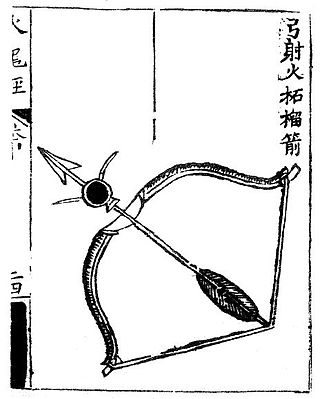
Fire arrows were one of the earliest forms of weaponized gunpowder, being used from the 9th century onward. Not to be confused with earlier incendiary arrow projectiles, the fire arrow was a gunpowder weapon which receives its name from the translated Chinese term huǒjiàn (火箭), which literally means fire arrow. In China a 'fire arrow' referred to a gunpowder projectile consisting of a bag of incendiary gunpowder attached to the shaft of an arrow. Fire arrows are the predecessors of fire lances, the first firearm.
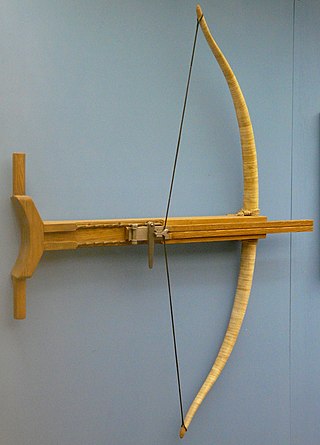
The gastraphetes, also called belly bow or belly shooter, was a hand-held crossbow used by the Ancient Greeks. It was described in the 1st century AD by the Greek author Heron of Alexandria in his work Belopoeica, which draws on an earlier account of the famous Greek engineer Ctesibius. Heron identifies the gastraphetes as the forerunner of the later catapult, which places its invention some unknown time prior to c. 420 BC.

Archery, or the use of bow and arrows, was probably developed in Africa by the later Middle Stone Age. It is documented as part of warfare and hunting from the classical period until the end of the 19th century, when it was made obsolete by the invention and spread of repeating firearms.
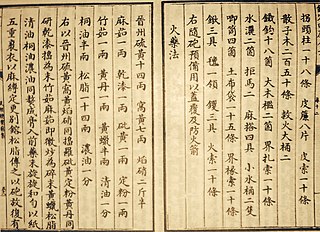
Gunpowder is the first explosive to have been developed. Popularly listed as one of the "Four Great Inventions" of China, it was invented during the late Tang dynasty while the earliest recorded chemical formula for gunpowder dates to the Song dynasty. Knowledge of gunpowder spread rapidly throughout Asia and Europe, possibly as a result of the Mongol conquests during the 13th century, with written formulas for it appearing in the Middle East between 1240 and 1280 in a treatise by Hasan al-Rammah, and in Europe by 1267 in the Opus Majus by Roger Bacon. It was employed in warfare to some effect from at least the 10th century in weapons such as fire arrows, bombs, and the fire lance before the appearance of the gun in the 13th century. While the fire lance was eventually supplanted by the gun, other gunpowder weapons such as rockets and fire arrows continued to see use in China, Korea, India, and this eventually led to its use in the Middle East, Europe, and Africa. Bombs too never ceased to develop and continued to progress into the modern day as grenades, mines, and other explosive implements. Gunpowder has also been used for non-military purposes such as fireworks for entertainment, or in explosives for mining and tunneling.
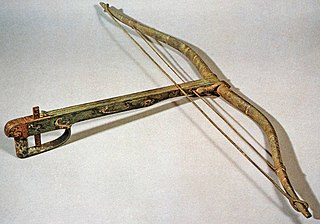
It is not clear where and when the crossbow originated, but it is believed to have appeared in China and Europe around the 7th to 5th centuries BC. In China the crossbow was one of the primary military weapons from the Warring States period until the end of the Han dynasty, when armies were composed of up to 30 to 50 percent crossbowmen. The crossbow lost much of its popularity after the fall of the Han dynasty, likely due to the rise of the more resilient heavy cavalry during the Six Dynasties. One Tang dynasty source recommends a bow to crossbow ratio of five to one as well as the utilization of the countermarch to make up for the crossbow's lack of speed. The crossbow countermarch technique was further refined in the Song dynasty, but crossbow usage in the military continued to decline after the Mongol conquest of China. Although the crossbow never regained the prominence it once had under the Han, it was never completely phased out either. Even as late as the 17th century AD, military theorists were still recommending it for wider military adoption, but production had already shifted in favour of firearms and traditional composite bows.

An arrowslit is a narrow vertical aperture in a fortification through which an archer can launch arrows or a crossbowman can launch bolts.
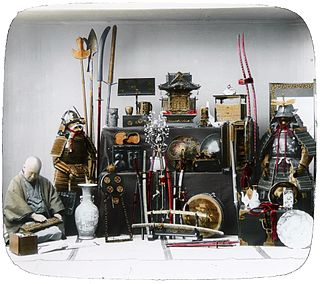
Major innovations in the history of weapons have included the adoption of different materials – from stone and wood to different metals, and modern synthetic materials such as plastics – and the developments of different weapon styles either to fit the terrain or to support or counteract different battlefield tactics and defensive equipment.
Gunpowder weapons in the Song dynasty included fire arrows, gunpowder lit flamethrowers, soft shell bombs, hard shell iron bombs, fire lances, and possibly early cannons known as "eruptors". The eruptors, such as the "multiple bullets magazine eruptors", consisting of a tube of bronze or cast iron that was filled with about 100 lead balls, and the "flying-cloud thunderclap eruptor", were early cast-iron proto-cannons that did not include single shots that occluded the barrel. The use of proto-cannon, and other gunpowder weapons, enabled the Song dynasty to ward off its generally militarily superior enemies—the Khitan led Liao, Tangut led Western Xia, and Jurchen led Jin—until its final collapse under the onslaught of the Mongol forces of Kublai Khan and his Yuan dynasty in the late 13th century.

Volley fire, as a military tactic, is the concept of having soldiers shoot in the same direction en masse. In practice, it often consists of having a line of soldiers all discharge their weapons simultaneously at the enemy forces on command, known as "firing a volley", followed by more lines of soldiers repeating the same manoeuvre in turns. This is usually to compensate for the inaccuracy, slow rate of fire, limited effective range and stopping power of individual weapons, which often requires a massed saturation attack to be effective. The volley fire, specifically the musketry volley technique, requires lines of soldiers to step to the front, fire on command and then march back into a column to reload, while the next row repeats the same process.

Bo hiya is the Japanese version of the fire arrow. Bo-hiya were used in ancient Japan and by the samurai class of feudal Japan.

This is an overview of Chinese siege weapons.

The three most common types of Chinese polearms are the ge (戈), qiang (槍), and ji (戟). They are translated into English as dagger-axe, spear, and halberd. Dagger-axes were originally a short slashing weapon with a 0.9–1.8 m long shaft, but around the 4th century BC a spearhead was added to the blade, and it became a halberd. The spear is also sometimes called a mao (矛), which is sometimes used to designate polearms with a wavy snake-like spearhead. There was another polearm weapon known as the pi (鈹), translated into English as either sword-staff or long lance, that was used from ancient times until the Han dynasty. It was essentially a short sword attached to a stick. From the Warring States period onward, the length of Chinese polearms varied from around 2.8 to 5.5 m ; however, there is no specific designation for a pike in the traditional Chinese lexicon. A very long spear is just called a long spear.

The Austroasiatic crossbow which is also known as the Hmong crossbow, the Jarai crossbow, or the Angkorian crossbow is a crossbow used for war and for hunting in Southeastern Asia. It has become a symbol of pride and identity for ethnic groups from Myanmar (Burma) to the confines of Indochina.
References
- 1 2 3 Japanese Castles AD 250--1540 [ permanent dead link ], Stephen Turnbull, Peter Dennis, Illustrated by Peter Dennis, Osprey Publishing, 2008 ISBN 9781846032530 P.49
- ↑ "Shudo (手弩) and Ōyumi (大弓) - Japanese Crossbows".
- ↑ Louis, Thomas; Ito, Tommy (August 2008). Samurai: The Code of the Warrior. ISBN 9781402763120.
- ↑ Hired Swords: The Rise of Private Warrior Power in Early Japan, By Karl Friday, Stanford: Stanford University Press, 1992 P.42
